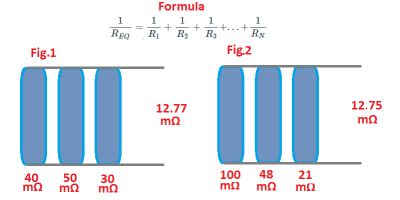You are using an out of date browser. It may not display this or other websites correctly.
You should upgrade or use an alternative browser.
You should upgrade or use an alternative browser.
I R
- Thread starter robbymax
- Start date

italianuser
Moderator
- Joined
- Feb 25, 2020
- Messages
- 781
This is the section in the forum you can search in:
https://secondlifestorage.com/index.php?forums/cell-data-specifications.30/
https://secondlifestorage.com/index.php?forums/cell-data-specifications.30/
Many cells are missing datasheets, Wolf's IR cheat sheet https://drive.google.com/drive/folders/1UOQUXa4Kwa99KoeuNDe7EV3iSECb8iIs is a good place to start.
later floyd
later floyd
Wolf
Moderator
- Joined
- Sep 25, 2018
- Messages
- 2,009
Datasheets for the cell
@robbymax
A 12 volt Li based battery is probably a LiFePo4 Battery and the IR of the whole battery will be skewed by the BMS system.
The best way to test the IR of cells is without any connections to them.
IR values are dependent on cell chemistry so the results can vary greatly.
Wolf
Wolf
Moderator
- Joined
- Sep 25, 2018
- Messages
- 2,009
Well the battery above looks like a 10p14s and is already built. Looks quite good. 
What we usually do is check the IR of the cells before the assembly and as first touch to determine the quality of the individual cell.
Once all the cells are put together into a battery you cannot check each individual cell for IR.
Wolf
What we usually do is check the IR of the cells before the assembly and as first touch to determine the quality of the individual cell.
Once all the cells are put together into a battery you cannot check each individual cell for IR.
Wolf
Some smart bms's do individual cell IR. Not sure which ones. Most likely would be IR by dc method which may be inaccurate. You can measure the IR of the whole pack with most Ac IR meters. just use the most positive and the most negative of your pack before the BMS and if your IR meter can handle the voltage it should give you an IR reading. but individual cell IR doubtful.
Later floyd
Later floyd
Wolf
Moderator
- Joined
- Sep 25, 2018
- Messages
- 2,009
Sure you can read IR (Internal resistance) on anything. Same as you can read IR on a capacitor in a circuit or the impedance of a choke but if they are in a circuit especially if they are powered up the readings are more than likely not valid.i thought i wouldbe able to read the IR ?
The issue is once you have anything in parallel the rules change. Also if you add electronic components, passive or not it will change as everything has impedance/resistance even the 'balancing" wires have a capacitance/resistance/impedance. Mostly too little to worry about but nevertheless its there. Therefore it is recommended that the balance wires on a BMS should all be the same length.
Here is an example of how resistance works in parallel. Fig.1 and Fig. 2 have essentially the same end result but vastly different individual readings.
So you see you cannot judge the individual cells IR by the end result.
Wolf

To get accurate & meaningful readings, like said above, you need to:
a) be testing a single cell separately one at a time
b) test at the cells terminals not after the BMS. (BMS FET & wiring resistance affects readings)
With a) sure, yes you can test an assembled battery pack like in your pics (nice, like them!). Trick is if there's a bad/high IR cell in the pack, you wouldn't know.
Re what is a good IR vs bad IR number, best to find the manufactures spec. I'm totally guessing but <40mOhms would be a starting suggestion for your LiFeP04 26650.
I googled "26650 lifepo4 datasheet" & found this example spec showing <20mOhms:
a) be testing a single cell separately one at a time
b) test at the cells terminals not after the BMS. (BMS FET & wiring resistance affects readings)
With a) sure, yes you can test an assembled battery pack like in your pics (nice, like them!). Trick is if there's a bad/high IR cell in the pack, you wouldn't know.
Re what is a good IR vs bad IR number, best to find the manufactures spec. I'm totally guessing but <40mOhms would be a starting suggestion for your LiFeP04 26650.
I googled "26650 lifepo4 datasheet" & found this example spec showing <20mOhms:




